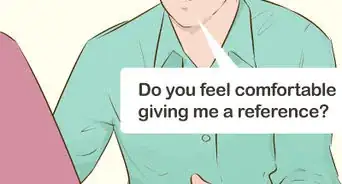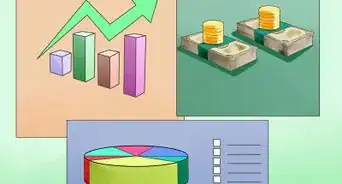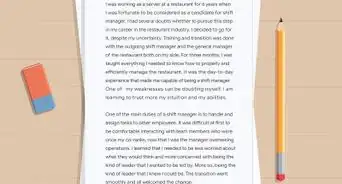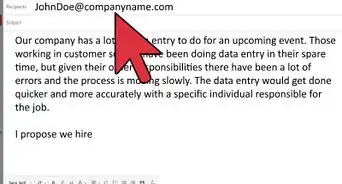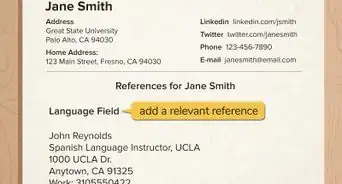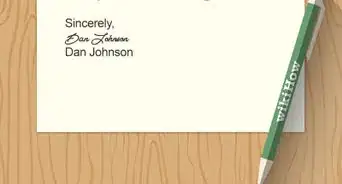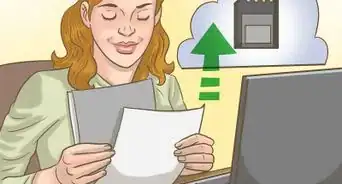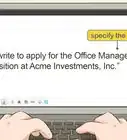This article was co-authored by Shannon O'Brien, MA, EdM. Shannon O'Brien is the Founder and Principal Advisor of Whole U. (a career and life strategy consultancy based in Boston, MA). Through advising, workshops and e-learning Whole U. empowers people to pursue their life's work and live a balanced, purposeful life. Shannon has been ranked as the #1 Career Coach and #1 Life Coach in Boston, MA by Yelp reviewers. She has been featured on Boston.com, Boldfacers, and the UR Business Network. She received a Master's of Technology, Innovation, & Education from Harvard University.
There are 11 references cited in this article, which can be found at the bottom of the page.
wikiHow marks an article as reader-approved once it receives enough positive feedback. In this case, 100% of readers who voted found the article helpful, earning it our reader-approved status.
This article has been viewed 1,080,742 times.
After submitting an application or doing an interview it can be nerve-racking waiting to hear back, wondering how you did and what they thought of you. Communicating in the right way with the company can set you apart from the competition. Look at follow up emails as more opportunities to express your interest in the position and make a good impression. As long as you're professional and don't sound pushy, the employer will appreciate your letter and eagerness for the position.
Steps
Help Following up on an Application
Checking on the Status of Your Application
-
1Give it at least a few days before sending an email. Though there are mixed reports about how long you should wait to follow up on a job application, the general consensus is that you should wait at least 3 to 5 days.
- In fact, some hiring managers say that they prefer not to receive follow up emails at all. They believe that it is an attention-grabbing tactic and takes away from the time they need to select qualified candidates. That said, others say that following up will make you stand out in a good way.[1]
- Just remember that it's possible that dozens of applicants applied for the same position as you did, and that it takes time to sort through applications and find qualified candidates for the next round. You don't want to seem pushy or impatient by following up too soon.[2]
-
2Address your email to the correct person. Ideally, you should address your email to the same person you reached out to when you applied for the job. If you can’t find the name, then "Dear Hiring Manager" may be the best you can do.[3]
- You may be able to find the contact information for the hiring manager on the company website or LinkedIn page.
- Always check the spelling. Nothing can create a negative impression quicker than misspelling someone's name.
Advertisement -
3Make the subject specific and direct. Something simple like, "Application Follow-Up for Editor Position" will do the trick. If the position had a reference or requisition number, then you can add that as well.
- Remember that the hiring manager may be hiring for multiple positions at once, so it's important to be as specific as possible. You can even put your name in the subject to make it easier for the hiring manager to find your application.
-
4Write the correct greeting. Simply write "Dear" in front of the hiring manager’s name, just as you did when you wrote your cover letter. Don't fall into being too informal and say "Hi" or "Hey" just because it's an email—it's important to keep things on the formal side for now.
- "Dear Mr. Smith" is an appropriate salutation.
-
5State the position you applied for and when. Start off by saying when you applied for the position, how you found it, and that you are checking on the status. You can add that you would like to make sure that they received your materials.[4]
- You can say something simple like, “Dear Mr. Smith, Last week I applied for the Editor position you advertised through Jobster. I have not yet heard back from Writerly Company regarding this position and would like to confirm that my application was received."
-
6Reinforce your enthusiasm and qualifications for the position.[5] Tell the hiring manager that you're excited to apply for the position and explain why you'd be a great fit. Really detail your qualifications for the position.[6]
- Try, "My enthusiasm and experience make me a great fit for this position. I have been an editor for a lifestyle magazine for the past 5 years and am excited about the opportunity to take my writing and editing experience to the next level with your company."
-
7Keep the closing short and simple but enthusiastic. End your email with a positive statement saying that you look forward to hearing from them soon. You can also make an offer to resend any files in case they were not forwarded correctly. Be sure to thank them for their time.
- For example, "Please contact me at any time if you have questions about my qualifications or need any additional materials. I look forward to hearing from you and want to thank you for your time."
- Sign it "Sincerely, Your Name" with your phone number on the next line.
-
8Proofread your draft before you send it. Double check your spelling and grammar, and assess and fine tune the general flow of the email. Getting this right can be as important as having a polished cover letter and resume, so give it the attention it deserves. Once you are feeling confident, hit the send button.
- Try reading your draft out loud to make sure it flows smoothly and makes sense.
-
9Practice patience while you wait for a response. Now that your email is complete, give it some breathing room. Be confident that the strength of your resume and cover letter coupled with your persistence in following up, will put you in a strong position to land an interview.
- Though some people are tempted to follow up over the telephone, you should make sure you've been patiently waiting before you consider this move. A phone call may help you stand out as a candidate, but it may also come off as pushy.
- If you do decide to make a phone call, make sure you sound confident yet respectful, and remind the hiring manager why you're a good fit.
Sending a Thank You Email After the Interview
-
1Start off with a strong, direct subject line. It’s possible the hiring manager receives tons of emails. To make your email stand apart from others, be direct in the subject line so it grabs their attention.[7]
- Try writing something like, "Editor Interview-Thank you." If the position had a reference or requisition number, then you can add that to the subject line as well.
-
2Address your email to the correct person. You should address your email to the person or people you interviewed with. If you don’t remember all of the names, you should at least remember the name of the main interviewer. If not, check the company website for clues or call the front desk and simply ask.[8]
-
3Thank the interviewer for their time while being sincere and specific. Mentioning the specific position, and even the time and date of the interview, is a helpful reference in the case that they have conducted many interviews.[9]
- Don’t just say “Thank you for your time.” Try saying something like, “Thank you for the opportunity to interview for the editor position with The Writerly Company. I truly appreciate your time and consideration.”
-
4Express your enthusiasm for the position and/or the company.[10] Tell them specifically what you like about the company. Is the company employee owned? Is it a local business? Are they an innovator in the technology market? Tell them whatever it is that makes the company stand out to you.[11]
- You could write, “I know there are few companies as innovative as yours in which I could advance my career in the field.”
- Or, “I would be honored to work for a company that values their employees as much as yours does.”
-
5Reemphasize why you would be the best fit for the position. If it helps, look back at the job description on the job posting to find the qualifications and attributes they are looking for. If their ideal candidate has strong communication skills, tell them how amazing your communication skills are.[12]
- In general, an employer will appreciate an applicant who is reliable, motivated, and has a strong desire to contribute to the company’s success.[13] Be sure to mention these things.
-
6Mention information that wasn’t made clear during the interview. Maybe you forgot to tell them about relevant work experience or a situation that could lend itself well for you in this position. If you thought about a more thorough answer or explanation to one of their questions, use this time to revisit it.[14]
-
7Give the employer an opportunity to ask you any follow up questions. In your closing lines, let them know that you are willing to talk and discuss any questions or concerns they may have.[15]
- Say something like, “Please don’t hesitate to contact me via phone or email if you have any additional questions or concerns you would like to address. If you would like to meet in person, please respond with a date and time and I would be happy to clear my schedule.”
- Don’t forget to list your phone number at the bottom of the email for easy reference.
-
8Proofread your email carefully. After you’ve written the email, take a short break and then come back to it. Read over the email carefully to check for spelling and grammar mistakes and autocorrects that were made in error. Then check the general flow of the email.[16]
- Remember, you are still trying to make a good impression so proofreading and editing is crucial.
- Reading your draft out loud can be helpful in making sure that it flows smoothly and makes sense. This can also give you a sense of whether or not you've maintained an enthusiastic, respectful tone.
-
9Send your email to everyone you interviewed with within 24 hours. The interview is still fresh in everyone’s memory during this time frame. A timely thank you email shows the interviewers your eagerness for the position and makes it more likely that they will remember who you are.[17]
Checking in If You Don’t Hear Back
-
1Wait until the established time frame has passed to send another email. If the employer indicated that they hope to make a decision within 1 week, then send the email sometime after that point; if they said 2 weeks, then wait at least the 2 full weeks.[18]
- You don't want to seem pushy or impatient by following up too soon. It's possible that they conducted multiple interviews and for various positions, so it could take some time to get everything processed.[19]
-
2Make the subject line direct and specific. By this point, the interviewers and hiring manager may have conducted many more interviews, so it's important to be as specific as possible. You can even put your name in the subject line to make it easier for them to find your application.
- Try something like, "Interview Follow-Up for Editor Position" or “Follow Up on Interview 06/12/2018, Jane Doe.” If the position had a reference or requisition number, then you can add that to the subject.
- Try replying to an old email thread. The “Re:” that will display in front of the subject makes it appear as part of a previous communication and they may be more likely to open it sooner.[20]
-
3Address your email to the same person you have been in contact with. If you were unable to find all of the names for who you interviewed with, just send it to the same people you sent the thank you email to.
-
4State the position you interviewed for and that you are still interested. Keep it short and simple. Also include when you interviewed and with whom, and indicate that you have not heard back yet.[21]
- It may look something like, "I’m writing regarding the Editor position I interviewed for last Monday. You mentioned that you hoped to make a final decision by the end of the week. I have not yet heard back from you regarding this position so just wanted to check in. I am looking forward to an update."[22]
-
5Finish the email with an enthusiastic closing. Close with a positive statement saying that you look forward to hearing from them soon. You can also confirm your contact details and offer them to contact you with any additional questions they may have. Keep it short and simple while showing how much the position would mean to you.
- "Please feel free to contact me if you have questions or need any additional information from me. I want to thank you for your time and look forward to hearing back from you soon."
- End with “Sincerely, Your Name.”
-
6Proofread and edit your draft. Step away from your email for a small period of time and then come back to it. Read over your email carefully to check for spelling and grammar mistakes and to fine tune the general flow of the letter.
- Read your draft out loud to make sure it has a polite, professional tone, flows smoothly, and makes sense.
-
7Sit back and wait for a response. At this point, you can acknowledge that you tried your best to apply for the position. You submitted a strong application, got an interview, and followed up on it.
- Don't be discouraged if you don't hear back right away. It can take quite a bit of time for hiring managers to complete interviews and follow up with applicants.
Expert Q&A
Did you know you can get expert answers for this article?
Unlock expert answers by supporting wikiHow
-
QuestionHow do you politely ask for a status update?
 Shannon O'Brien, MA, EdMShannon O'Brien is the Founder and Principal Advisor of Whole U. (a career and life strategy consultancy based in Boston, MA). Through advising, workshops and e-learning Whole U. empowers people to pursue their life's work and live a balanced, purposeful life. Shannon has been ranked as the #1 Career Coach and #1 Life Coach in Boston, MA by Yelp reviewers. She has been featured on Boston.com, Boldfacers, and the UR Business Network. She received a Master's of Technology, Innovation, & Education from Harvard University.
Shannon O'Brien, MA, EdMShannon O'Brien is the Founder and Principal Advisor of Whole U. (a career and life strategy consultancy based in Boston, MA). Through advising, workshops and e-learning Whole U. empowers people to pursue their life's work and live a balanced, purposeful life. Shannon has been ranked as the #1 Career Coach and #1 Life Coach in Boston, MA by Yelp reviewers. She has been featured on Boston.com, Boldfacers, and the UR Business Network. She received a Master's of Technology, Innovation, & Education from Harvard University.
Life & Career Coach
-
QuestionTo whom do I address a follow-up email if I don't have the name of the hiring manager?
 Community Answer"Dear Hiring Manager" is how you address the hiring manager. Be sure, though, that you are indeed emailing the hiring manager.
Community Answer"Dear Hiring Manager" is how you address the hiring manager. Be sure, though, that you are indeed emailing the hiring manager. -
QuestionIf I have a general HR department email, how can I know that I'm indeed emailing the hiring manager? Is "To whom it may concern" a reasonable substitute?
 Community AnswerIt would be better saying "Dear HR representative" instead. "To whom it may concern" is a very broad, generic and old-fashioned statement that I would avoid.
Community AnswerIt would be better saying "Dear HR representative" instead. "To whom it may concern" is a very broad, generic and old-fashioned statement that I would avoid.
Warnings
- Consider your email address and what is says about you. Avoid sending work related emails from accounts like "hotsurferdude" or "shopaholicgirl." Instead, create another account using your name or something professional.⧼thumbs_response⧽
- Never be pushy, demanding or overbearing. Do not be rude in your communication to the hiring manager as they hold the ultimate decision. They understand the process of recruitment is important to you, but most likely it is only a small part of their day so being rude or pushy will only create a negative impression.⧼thumbs_response⧽
References
- ↑ http://www.careercast.com/career-news/when-follow-after-applying-job
- ↑ http://www.snagajob.com/resources/sample-application-follow-up-email/
- ↑ http://money.usnews.com/money/blogs/outside-voices-careers/2012/01/23/how-to-follow-up-on-your-job-application
- ↑ http://money.usnews.com/money/blogs/outside-voices-careers/2012/01/23/how-to-follow-up-on-your-job-application
- ↑ Shannon O'Brien, MA, EdM. Life & Career Coach. Expert Interview. 10 December 2019.
- ↑ http://career-advice.monster.com/job-search/getting-started/recruiter-roundtable-the-followup-hot-jobs/article.aspx
- ↑ https://careersidekick.com/follow-up-after-interview-no-response/
- ↑ https://www.monster.com/career-advice/article/awkward-interview-follow-ups
- ↑ https://careersidekick.com/follow-up-after-interview-no-response/
- ↑ Shannon O'Brien, MA, EdM. Life & Career Coach. Expert Interview. 10 December 2019.
- ↑ https://www.thebalancecareers.com/job-interview-follow-up-thank-you-letter-email-2063971
- ↑ https://www.thebalancecareers.com/job-interview-follow-up-thank-you-letter-email-2063971
- ↑ https://www.ziprecruiter.com/blog/the-right-way-to-follow-up-after-a-job-interview/
- ↑ https://www.ziprecruiter.com/blog/the-right-way-to-follow-up-after-a-job-interview/
- ↑ https://www.indeed.com/career-advice/interviewing/follow-up-email-examples-after-interview
- ↑ https://www.grammarly.com/blog/thank-you-email-after-interview/
- ↑ https://www.ziprecruiter.com/blog/the-right-way-to-follow-up-after-a-job-interview/
- ↑ https://www.ziprecruiter.com/blog/the-right-way-to-follow-up-after-a-job-interview/
- ↑ https://careersidekick.com/follow-up-after-interview-no-response/
- ↑ https://careersidekick.com/follow-up-after-interview-no-response/
- ↑ http://money.usnews.com/money/blogs/outside-voices-careers/2012/01/23/how-to-follow-up-on-your-job-application
- ↑ https://www.ziprecruiter.com/blog/the-right-way-to-follow-up-after-a-job-interview/
- ↑ https://www.ziprecruiter.com/blog/the-right-way-to-follow-up-after-a-job-interview/
About This Article
To write a follow-up email for a job application, wait at least 3 days after submitting your application before you send the email so you don't seem pushy or impatient. In your email, address the hiring manager directly if possible and start off by mentioning the job you applied for and when you submitted your application. Then, briefly restate your enthusiasm and qualifications for the position. Finally, close your email by letting them know where they can contact you if needed and thanking them for their time. For examples of some follow-up emails, scroll down!
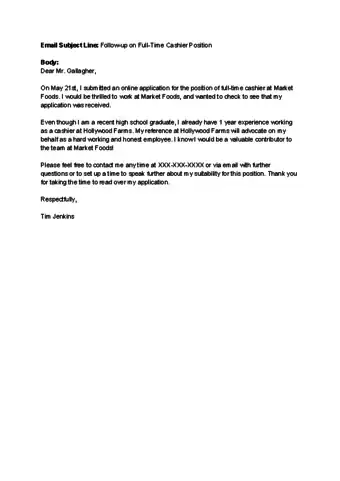
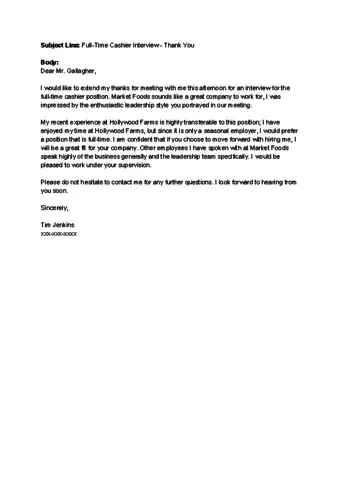
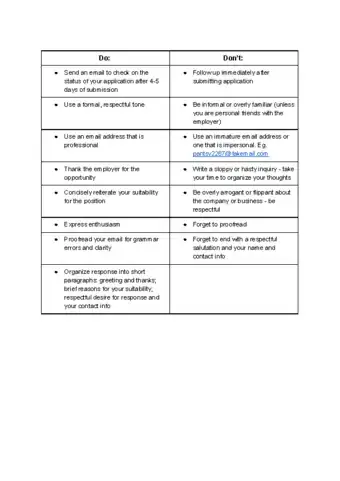
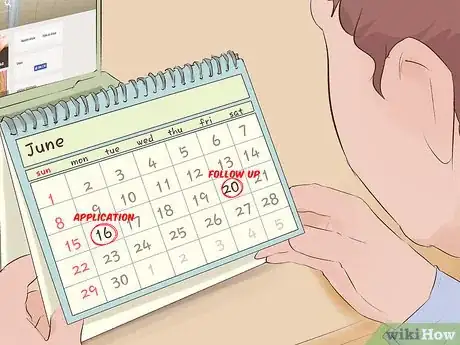
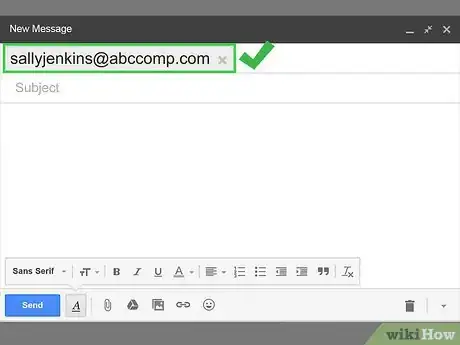

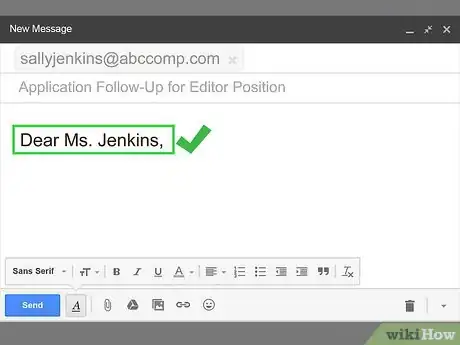
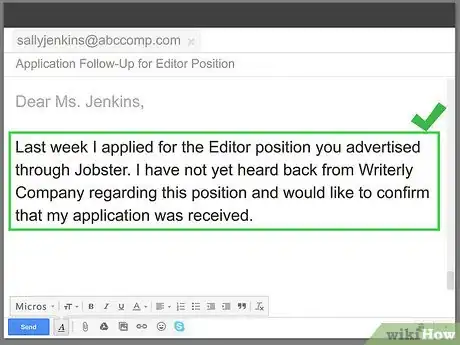
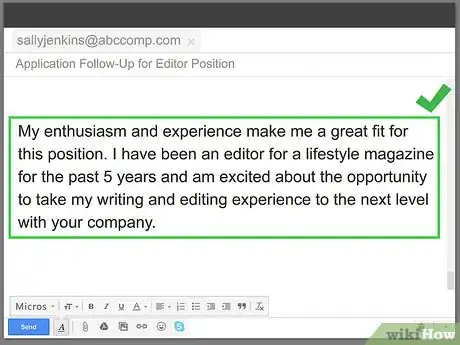

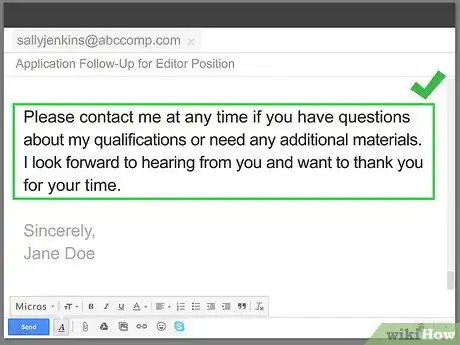
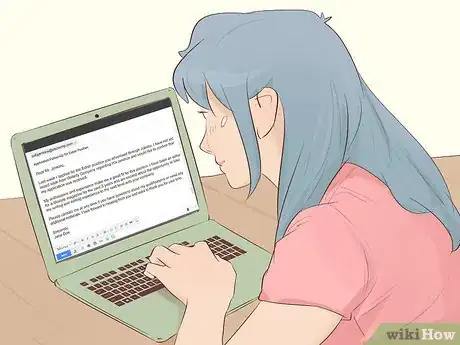

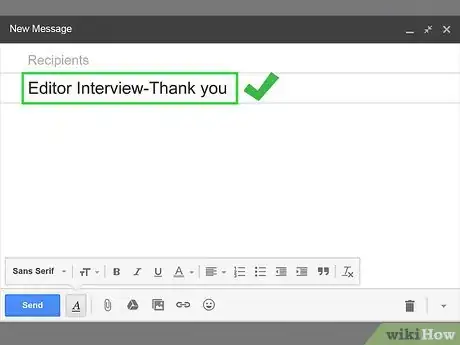

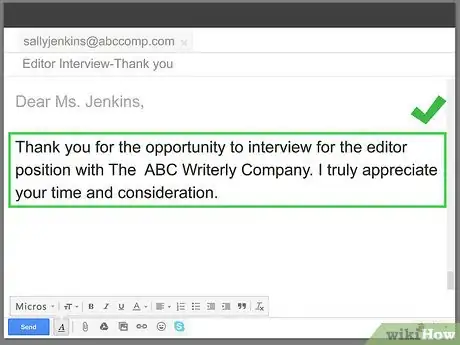
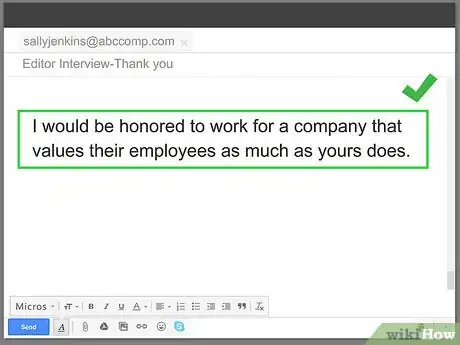

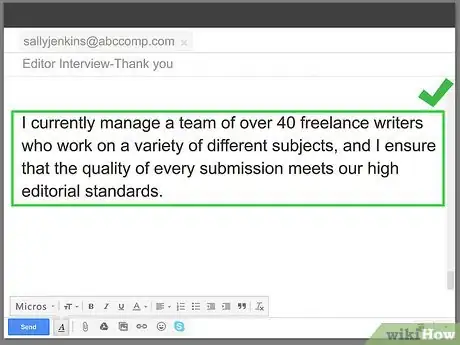
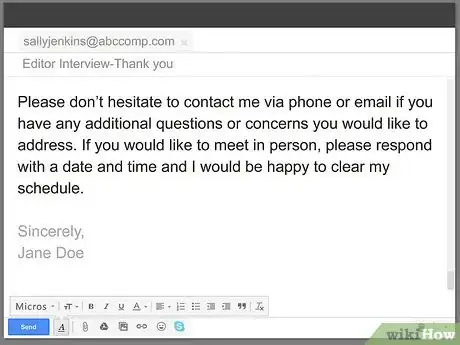
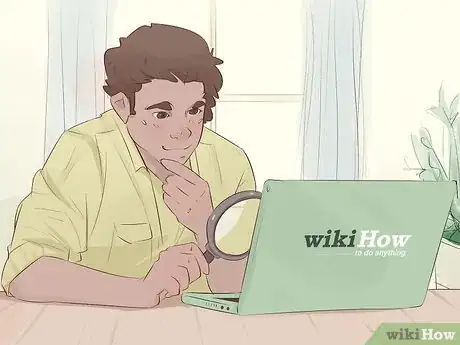
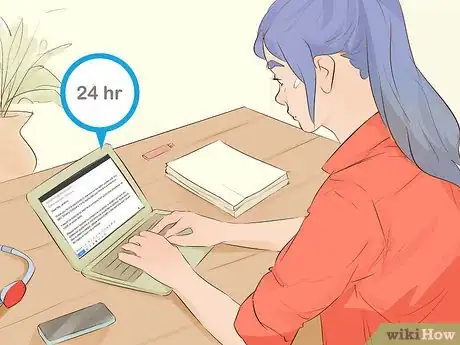

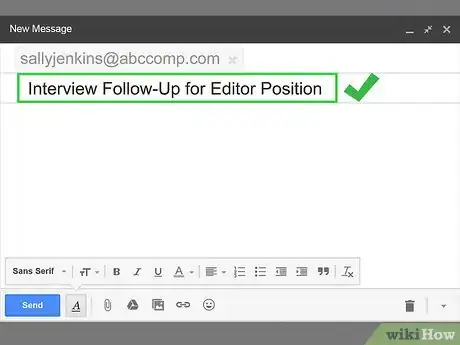
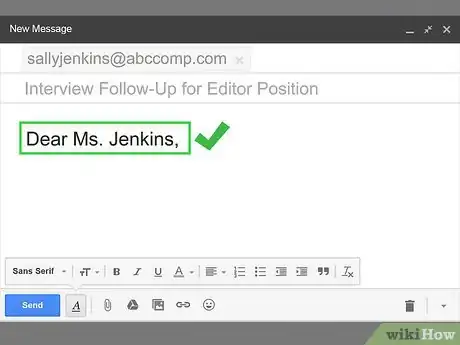
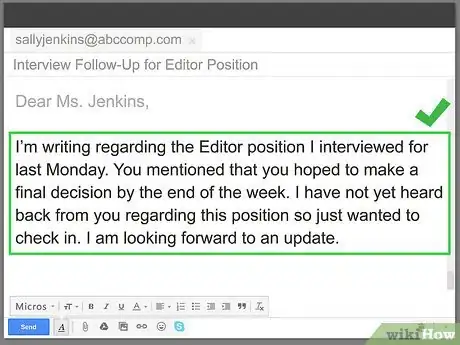
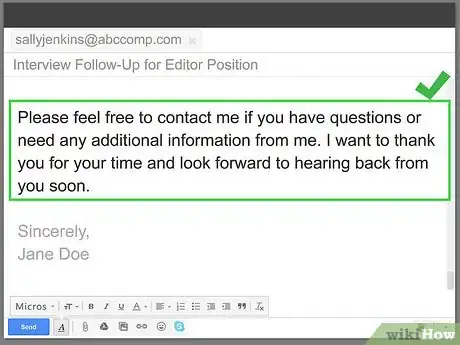
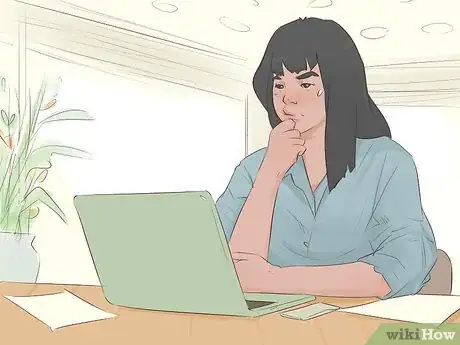
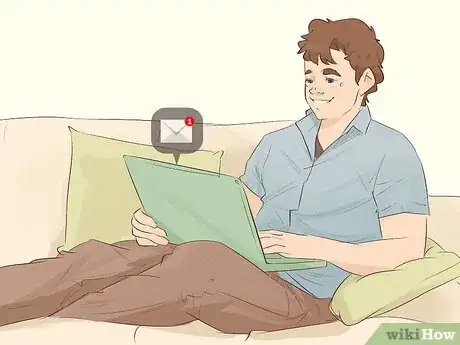
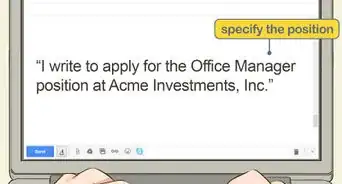
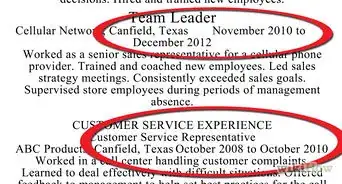


-Step-17-Version-3.webp)


